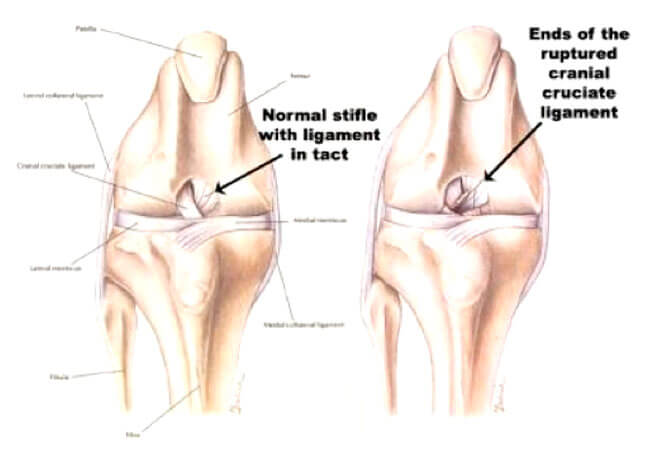Cruciate Ligament Rupture
There are two bands of fibrous tissue called the cruciate ligaments in each knee joint. They join the femur and tibia (the bones above and below the knee joint) together so that the knee works as a hinged joint.
They are called cruciate ligaments because they “cross over” inside the knee joint. One ligament connects from inside to outside the knee joint and the other outside to inside, crossing each other in the middle.
Humans have the same anatomical structure of the knee. Cruciate ligament rupture is a common knee injury of athletes. The term anterior cruciate is used to describe the identical anatomical structure in humans.
How does a cranial cruciate injury occur?
The knee joint is a hinged joint and only moves in one plane, backwards and forwards. Traumatic cruciate damage is caused by a twisting injury to the knee joint. This is most often seen in dogs and athletes when running and suddenly changing direction so that the majority of the weight is taken on this single joint. This injury usually affects the anterior or cranial (front) ligament. The joint is then unstable and causes extreme pain, often resulting in lameness.
More commonly, a chronic form of cruciate damage can occur due to weakening of the ligaments as a result of disease. The ligament may become stretched or partially torn and lameness may be only slight and intermittent, but a process of inflammation, or arthritis, is occurring in the joint at the same time. With continued use of the joint, the condition gradually gets worse until rupture occurs.
The injury occurs commonly in obese dogs.

Diagram 1. Anatomy of the knee
How is it diagnosed?
With traumatic cruciate rupture, the usual history is that the dog was running and suddenly stopped or cried out and was then unable to bear weight on the affected leg.
Many pets will “toe touch” and place only a small amount of weight on the injured leg.
During the examination, the veterinarian will try to demonstrate a particular movement, called a drawer sign. This indicates laxity in the knee joint. Many dogs will require sedation or anaesthesia before this test can be performed due to the severe pain they are experiencing. Other diagnostic tests such as radiographs (x-rays) may also be necessary.
Tests such as arthroscopy may be needed to rule out other damage to the joint.

Diagram 2. Normal ligaments compared to a ruptured cranial cruciate ligament Hills Atlas
Is other joint damage common?
Inside the knee joint are pieces of cartilage called menisci. The menisci act as shock absorbers between the femur and tibia. Many times these cartilages are also damaged when the cruciate ligaments rupture. They are usually repaired at the same time as the ligament surgery.
Is an operation always necessary?
Dogs under 10kg may improve without surgery, but joint damage and arthritis will continue to develop if the joint is not stable. These patients are often restricted to cage rest for two to six weeks. Dogs over 10kg usually require surgery to heal. Unfortunately, most dogs will eventually require surgery to correct this painful injury.
What does surgery involve?
There are various techniques available to replace the action of the cruciate ligaments. These surgeries most often involve the placement of artificial ligaments along the outside of the knee joint. There are newer surgical techniques available including Tibial Plateau Leveling Osteotomy (TPLO) or Triple Tibial Osteotomy (TTO) that are especially beneficial for larger, more athletic dogs. Your veterinarian will discuss with you the best treatment option for your pet.
Is post-operative care difficult?
It is important that your dog have limited activity for six to eight weeks after surgery. Provided you are able to carry out your veterinarian’s instructions, good function should return to the limb within three months. Unfortunately, regardless of the technique used to stabilise the joint, arthritis is likely to develop in the joint as your dog ages. Weight control and nutritional supplements such as glucosamine / chondroitin or synovan injections may help delay the onset of arthritis in your pet. Many dogs will receive physical therapy after the surgery to speed recovery and reduce complications. Your veterinarian will discuss your pet’s recommended post-operative care with you prior to surgery.
Is obesity such a problem?
Obesity can result in cruciate ligament rupture. If your dog is overweight, the recovery time will be much longer. Obesity also increases the risk of injury to the other knee. Weight loss is as important as surgery in ensuring rapid return to normal function.
How can you stop this from happening to your pet?
Tearing of the cruciate ligament occurs when the ligament is diseased and/or there are excessive forces placed on the knee. It most commonly occurs in overweight dogs when they are exercising. You can help to prevent this by keeping him/her at a healthy weight and managing any arthritis or joint pain that they may develop early on.
Please Contact Us to book an appointment.
